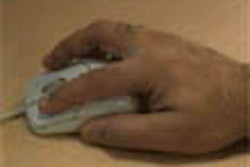Clinicians could potentially view medical images on their mobile phones, improving their access to PACS networks, according to an online article published in the Journal of Digital Imaging.
Hoping to help clinicians access PACS images without restrictions on time or location, researchers from Hong Kong Polytechnic University in Kowloon developed a mobile controller client software application. The software, embedded in a mobile phone, allows a clinician to access an institution's PACS and RIS network using various wireless communication modes.
"We have demonstrated the feasibility of using a mobile phone, in addition to a PDA, as a client workstation in accessing digital images through interfacing with PACS and RIS," the authors wrote. "Although the image detail is limited by its resolution and display intensity in the mobile display, the mobile controller can provide speedy delivery of images, such that radiologists can preview images before they have access to an image workstation and clinicians can review reported images through mobile phone display."
The image retrieval time depends on the General Packet Radio Service (GPRS) transfer when the user is outside the hospital complex, the researchers said. The data transfer rate ranges between 56 Kbps to 114 Kbps.
Clinicians typically access images inside the hospital through a local network, using image-viewing workstations. If they want to utilize a mobile phone inside the hospital for image viewing, they can do so through Bluetooth, at a transfer rate of 723 Kbps, the authors said.
Using the mobile phone system with GPRS, a CR image can be accessed in eight seconds; CT images of 24 slices can be accessed in 191 seconds.
Because phones have limited memory (usually less than 4 MB), both the preview images and the zoom-in image must be resized to a certain percentage of the original image size. Resizing enables most phones to read the image, greatly reducing download time as well, the authors wrote.
"This process will reduce the image detail to less than half of the image detail of the original DICOM image," they said.
A typical mobile phone (with resolution of 128 x 160 pixels or 176 x 208 pixels, with color depth of 65K to 260K colors) is insufficient for diagnostic viewing of a typical 512 x 512 pixel CT study at any single shot of view, let alone a typical CR chest image (2048 x 2048 pixels), the researchers noted.
"To view the whole image, the user must move the image in the small viewing window," they wrote.
The system, which requires only a mobile phone embedded with the client program, allows healthcare workers to monitor their patients from a distance, even when off-duty, the researchers wrote.
"This capability is particularly important in the case of urgent consultation, yet allows professional workers greater flexibility in their use of time," the team wrote. "Undoubtedly, the system could be of value for referring clinicians to obtain relevant images and accompanying diagnostic reports."
The researchers noted that further tests are required to evaluate the value of mobile communication for medical images in clinical context.
By Erik L. Ridley
AuntMinnie.com staff writer
September 1, 2004
Related Reading
Mobile computing aids ED/radiology communications, August 6, 2004
Security in the wired or wireless world: users are the weakest link, May 24, 2004
Tablet PCs show promise as mobile PACS workstations, May 23, 2004
New wireless network options offer benefits, despite security concerns, April 2, 2004
Tablet PC eases image distribution to bedside, March 23, 2004
Copyright © 2004 AuntMinnie.com


















